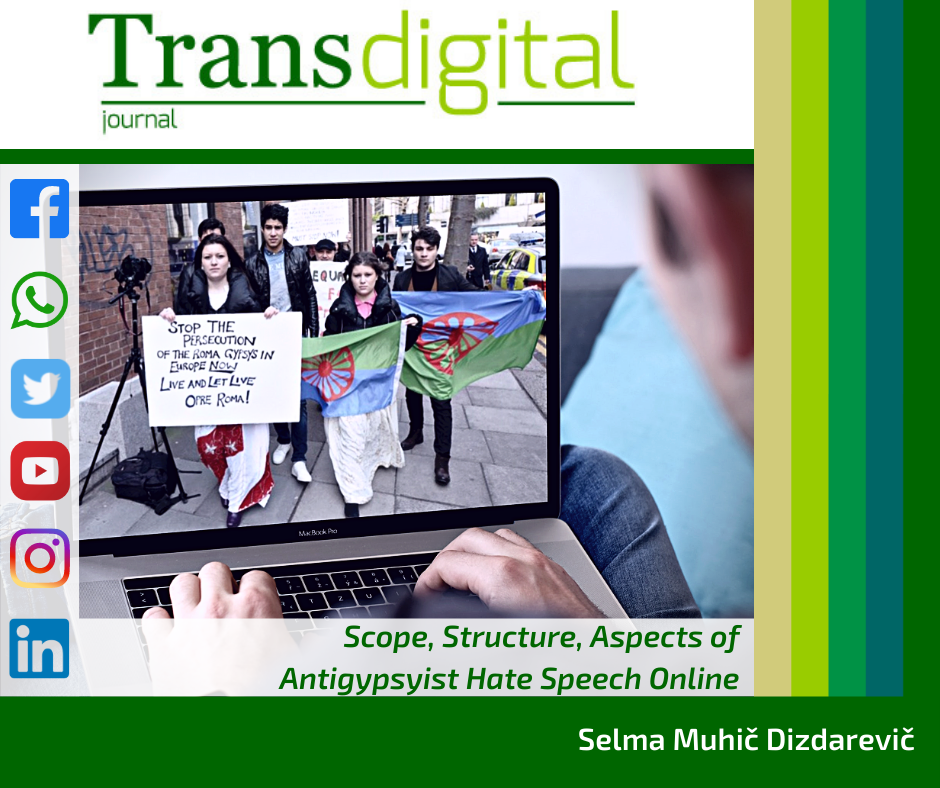Scope, Structure, Aspects of Antigypsyist Hate Speech Online
European Union context, monitoring and reporting
DOI:
https://doi.org/10.56162/transdigital79Keywords:
Antigypsyism, online hate speech, social media, Roma studies, nongovernmental organizationsAbstract
This article aims to provide the relevant parameters of the phenomena of antigypsyism, online hate speech, and their connection. The parameters serve as background for finding out about the trends in online hate speech directed at the Roma community, the most important concepts and tropes regarding antigypsyism, and the relevant trends in antigypsyist online hate speech. The article will focus on the European Union context because it provides a comparative political and legal framework and possibilities of joint activities and policies to tackle Roma discrimination. By combining scholarly resources and governmental reports, monitoring and reporting collected through nongovernmental organizations, it is concluded that the phenomenon of online antigypsyism is getting stronger. It mirrors offline hate speech and is relatively poorly monitored. It is spread via all mainstream social media platforms whose record on its removal tends to oscillate. A brief section is dedicated to intersectional aspects of antigypsyist hate speech whose iterations in the digital space are under-researched.
References
Alliance against Antigypsyism. (2016). Antigypsyism - a reference paper. https://secureservercdn.net/192.169.221.188/abv.a52.myftpupload.com/wp-content/uploads/2017/07/Antigypsyism-reference-paper-16.06.2017.pdf
ARA ART (2021). https://www.araart.cz/cs/roma-lgbt
Council of Europe. (2015). Human Rights Comment - Time to cure amnesia about the history of Roma in Europe. https://www.coe.int/en/web/commissioner/-/time-to-cure-amnesia-about-the-history-ofroma-in-europe?desktop=true
Council of Europe. (1997). RECOMMENDATION No. R (97) 20. https://search.coe.int/cm/Pages/result_details.aspx?ObjectID=0900001680505d5b
Council of Europe. (n.d.). Roma History/Holocaust. https://www.coe.int/en/web/roma-and-travellers/roma-history-/-holocaust
Crenshaw, K. (1989) Demarginalizing the Intersection of Race and Sex: A Black Feminist Critique of Antidiscrimination Doctrine, Feminist Theory and Antiracist Politics, University of Chicago Legal Forum, 1989(8). https://chicagounbound.uchicago.edu/uclf/vol1989/iss1/8
Data from the 4th monitoring exercise evaluation. https://ec.europa.eu/info/sites/info/files/code_of_conduct_factsheet_7_web.pdf
Data from the 5th monitoring exercise evaluation. https://ec.europa.eu/info/sites/info/files/codeofconduct_2020_factsheet_12.pdf
Digital Service Act, 2020. https://eur-lex.europa.eu/legal-content/en/TXT/?uri=COM:2020:825:FIN
ECRI. (2011). General Policy Recommendation No. 13 on Combating Anti-Gypsyism and Discrimination Against Roma. https://rm.coe.int/ecri-general-policy-recommendation-no-13-on-combating-anti-gypsyism-an/16808b5aee
European Commission, n.d. The EU Code of Conduct on Countering Illegal Hate Speech Online. https://ec.europa.eu/info/policies/justice-and-fundamental-rights/combatting-discrimination/racism-and-xenophobia/eu-code-conduct-countering-illegal-hate-speech-online_en
European Commission (2019). Code of Conduct on countering illegal hate speech online – Results of the fourth monitoring exercise. https://ec.europa.eu/info/sites/default/files/code_of_conduct_factsheet_7_web.pdf
European Commission (2020). Code of Conduct on countering illegal hate speech online – Results of the fifth monitoring exercise. https://ec.europa.eu/info/sites/default/files/codeofconduct_2020_factsheet_12.pdf
FRA. (2016). Second European Union Minorities and Discrimination Survey – Roma Selected Findings. https://fra.europa.eu/en/publication/2016/second-european-union-minorities-and-discrimination-survey-roma-selected-findings
FRA. (2018). A persisting concern: antigypsyism as a barrier to Roma inclusion. https://op.europa.eu/en/publication-detail/-/publication/b262c438-387b-11e8-b5fe-01aa75ed71a1/language-en
FRA. (2019). Second European Union Minorities and Discrimination Survey - Roma women in nine EU Member States. https://fra.europa.eu/sites/default/files/fra_uploads/fra-2019-eu-minorities-survey-roma-women_en.pdf
FRA, UNDP. (2012). The Situation of Roma in 11 EU Member States. https://fra.europa.eu/en/publication/2012/situation-roma-11-eu-member-states-survey-results-glance
Garmendia, M., & Karrera, I. (2019). ICT Use and Digital Inclusion among Roma/Gitano Adolescents. Media and Communication, 7(1), 22-31. https://doi.org/10.17645/mac.v7i1.1624
Gilbert, M. (2010). Theorizing digital and urban inequalities: Critical geographies of ‘race’, gender, and technological capital. Information, Communication and Society, 13(7). https://doi.org/10.1080/1369118X.2010.499954
Goméz, C., End, M (eds.), (2019). Dimensions of antigypsyism in Europe. European Network Against Racism and the Central Council of German Sinti and Roma.
Kóczé, A. (2009). Missing Intersectionality. Race/Ethnicity, Gender, and Class in Current Research and Policies on Romani Women in Europe. Center for Policy Studies, Central European University. https://cps.ceu.edu/sites/cps.ceu.edu/files/cps-policy-study-missing-intersectionality-2009.pdf
Láj?aková, J, Hojsík, M, Karoly, M (2020). Combatting Antigypsyism. European Commission. https://ec.europa.eu/info/sites/default/files/post2020_eu_roma_in_antigypsyism.pdf
Loveland, M. T., & Popescu, D. (2016). The Gypsy Threat Narrative: Explaining Anti-Roma Attitudes in the European Union. Humanity & Society, 40(3), 329–352. https://doi.org/10.1177/0160597615601715
Roma Civil Monitor, (2020). A synthesis of civil society’s reports on the implementation of national Roma integration strategies in the European Union. Identifying blind spots in Roma inclusion policy. https://cps.ceu.edu/sites/cps.ceu.edu/files/attachment/basicpage/3172/rcm-civil-society-monitoring-report-synthesis27-2020-eprint-fin.pdf
sCan project (2018). Antigypsyism on the Internet. http://scan-project.eu/wp-content/uploads/scan-antigypsyism.pdf
sCan project (2019). Intersectional Hate Speech Online. http://scan-project.eu/wp-content/uploads/sCAN_intersectional_hate_final.pdf
Slovo 21 (2014). Position of Roma Women in the Czech Republic – Research Results. http://www.slovo21.cz/images/dokumenty/POSITION%20OF%20ROMA%20WOMEN%20IN%20THE%20CZECH%20REPUBLIC%20-%20RESEARCH%20RESULTS.pdf
Talewicz-Kwiatkowska, J. (2015). Roma immigrants in western europe – the example of france and italy. Politeja, 31/2, 111–122. http://www.jstor.org/stable/24919779
Tilt, C.A. (2016). Corporate social responsibility research: the importance of context. International Journal of Corporate Social Responsibility, 1(2) https://doi.org/10.1186/s40991-016-0003-7
University of Graz (2021). Factsheets on Romani History. http://romafacts.uni-graz.at/?l_history=en#history
Van Dijk, J. (2005). The deepening divide: Inequality in the information society. Sage Publishing.
Y?ld?z,C., & De Genova, N. (2018). Un/Free mobility: Roma migrants in the European Union. Social Identities, 24(4), 425-441. https://doi.org/10.1080/13504630.2017.1335819.

Downloads
Autor de correspondencia
El autor de correspodencia se identifica con el siguiente símbolo: *Published
How to Cite
License
Copyright (c) 2021 Selma Muhi? Dizdarevi?

This work is licensed under a Creative Commons Attribution 4.0 International License.
All articles in Transdigital are licensed under a Creative Commons Attribution 4.0 International License. Authors hold the copyright and retain publishing rights without restrictions.









